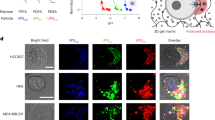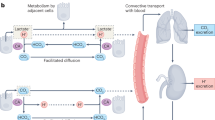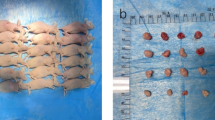Summary
An exposure of HL-60 human promyelocytic leukaemia cells to acidic media with pH 6.2–6.6 caused an up-regulation of Bax protein expression within 2 h, which lasted for longer than 6 h. On the other hand, the apoptosis, as judged from PARP cleavage, DNA fragmentation and flow cytometric determination of cell population with sub-G1 DNA content, occurred after the cells were incubated in the acidic media for longer than 4 h. The PARP cleavage and DNA fragmentation in the cells exposed to an acidic environment could be effectively suppressed by inhibitors specific for ICE or CPP32, indicating that activation of these caspases is an essential step in acidic stress-induced apoptosis. It has been known that Bax is involved in the activation of caspases. Taken together, it appears that acidic stress first up-regulates Bax protein thereby activating caspases followed by PARP cleavage and DNA fragmentation. The observation that inhibition of either ICE or CPP32 could suppress acidic stress-induced apoptosis suggested that ICE activates pro-CPP32, which then cleaves PARP. Flow cytometric analysis indicated that acidic stress-induced apoptosis occurs mainly in G1 cells. The finding in the present study demonstrated that acidic intra-tumour environment may markedly perturb the tumour cell proliferation and tumour growth.
Similar content being viewed by others
Article PDF
Change history
16 November 2011
This paper was modified 12 months after initial publication to switch to Creative Commons licence terms, as noted at publication
References
Aisenberg, A. C. (1961). The anaerobic and aerobic glycolysis of normal and tumor tissues. In The Glycolysis and Respiration of Tumors, Academic Press: New York 1–53.
Casciola-Rosen, L. A., Anhalt, G. J. & Rosen, A. (1995). DNA-dependent protein kinase is one of a subset of autoantigens specifically cleared early during apoptosis. J Exp Med 182: 1625–1634.
Chu, G. & Dewey, W. C. (1988). The role of low intracellular or extracellular pH in sensitization to hyperthermia. Radiat Res 114: 154–167.
Craig, R. W. (1995). The bcl-2 gene family. Semin Cancer Biol 6: 35–43.
Darmon, A. J., Nicholson, D. W. & Bleackley, R. C. (1995). Activation of the apoptotic protease CPP32 by cytotoxic T-cell-derived granzyme B. Natural 377: 466–448.
Darzynkiewicz, A., Bruno, S., Bino, G. D., Gorczyca, W., Hotz, M. A., Lassota, P. & Traganos, F. (1992). Feature of apoptotic cells measured by flow cytometry. Cytometry 13: 795–808.
Dewey, W. C., Ling, C. C. & Meyn, R. E. (1995). Radiation-induced apoptosis: relevance to radiotherapy. Int J Radiat Oncol Biol Phys 33: 781–796.
Duan, H., Chinnaiyan, A. M., Hudson, P. L., Wing, J. P., He, W. W. & Dixit, V. M. (1996). ICE-AP3, a novel mammalian homologue of the Caenorhabditis elegans cells death protein Ced 3, is activated during Fas- and tumor necrosis factor-induced apoptosis. J Biol Chem 271: 1621–1625.
Enari, M., Sakahira, H., Yokoyama, H., Iwamatsa, A. & Nagata, S. (1998). A caspase-activated DNase that degrades DNA during apoptosis, and its inhibitor/CAD. Nature 391: 43–50.
Furlong, I. J., Ascaso, R., Rivas, A. L. & Collins, M. K. L. (1997). Intracellular acidification induces apoptosis by stimulating ICE-like protease activity. J Cell Science 110: 653–661.
Griffiths, J. J. (1991). Are cancer cells acidic? Br J Cancer 64: 425–427.
Gullino, P. M. (1975). Extracellular compartments of solid tumors. In Biology of Tumors: Cellular Biology and Growth, Backer JJ (ed) cancer 3: Plenum Press: New York 327–354.
Haveman, J. (1979). The pH of the cytoplasm as an important factor in the survival of vitro cultured malignant cells after hyperthermia. Effects of carbonylcyanide-3-chlorophylhydrazone. Eur J Cancer 15: 1281–1288.
Jahde, E., Glusenkamp, K. H., Klunder, I., Hulser, D. F., Tietze, L. F. & Rajewsky, M. F. (1989). Hydrogen ion-mediated enhancement of cytotoxicity of bis-chlorethylating drug in rat mammary carcionoma cells in vitro. Cancer Res 49: 2965–2972.
Kaufmann, S. H., Desnoyers, S., Ottaviano, Y., Davidson, N. E. & Poirier, G. G. (1993). Specific proteolytic cleavage of poly(ADP)-ribose) polymerase: an early marker of chemotherapy-induced apoptosis. Cancer Res 53: 3976–3985.
Kim, G. E., Lyons, J. C., Levitt, S. H. & Song, C. W. (1991). Effects of amiloride on intracellular pH and thermosensitivity. Int J Radiat Oncol Biol Phys 20: 541–549.
Kumar, S. & Lavin, M. F. (1996). The ICE family of cysteine proteases as effectors of cell death. Cell Death Differ 3: 255–267.
Lazebnik, Y. A., Kaufman, S. H., Desnoyers, S., Poirier, G. G. & Earnshaw, W. C. (1994). Cleavage of poly (ADP-ribose) polymerase by a proteinase with properties like ICE. Nature 371: 346–347.
Lee, H. S., Park, H. J., Lyons, J. C., Griffin, R. J., Auger, E. A. & Song, C. W. (1997). Radiation-induced apoptosis in different pH environments in vitro. Int J Radiat Oncol Biol Phys 38: 1079–1087.
Liu, J. C. K. & Fox, M. H. (1995). Modification of intracellular pH and thermotolerance development by amiloride. Int J Hyperthermia 11: 511–523.
Liu, F-F, Sherar, M. D. & Hill, R. P. (1996). The relationship between intracellular pH and heat sensitivity in a thermoresistant cell line. Radiat Res 145: 144–149.
Negri, C., Bernardi, R., Braghetti, A., Ricotti, G. C. & Scovassi, A. I. (1993). The effect of the chemotherapeutic drug VP-16 on poly(ADP-ribosylation) in apoptotic HeLa cells. Carcinogenesis 14: 2559–2564.
Nicholson, D. W., Ali, A., Thornberry, N. A., Vaillancourt, J. P., Ding, C. K., Gallant, M., Gareau, Y., Griffin, P. R., Labelle, M. & Lazebnik, Y. A. et al (1995). Identification and inhibition of the ICE/CED-3 protease necessary for mammalian apoptosis. Nature 376: 37–43.
Park, H. J., Makepeace, C. M., Lyons, J. C. & Song, C. W. (1996). Effect of intracellular acidity and ionomycin on apoptosis in HL-60 cells. Eur J Cancer 32A: 540–546.
Ramage, P., Cheneval, D., Chvei, M., Graff, P., Hemming, R., Heng, R., Kocher, H. P., Mackenzie, A., Memmert, K. & Revesz, L. et al (1995). Expression, refolding and autocatalytic proteolytic processing of the interleukin-1β-converting enzyme precursor. J Biol Chem 270: 9378–9383.
Sakahira, H., Enari, M. & Nagata, S. (1998). Cleavage of CAD inhibitor in CAD activation and DNA degradation during apoptosis. Nature 391: 96–99.
Schlegel, J., Peters, I., Orrenius, S., Miller, D. K., Thornberry, N. A., Yamin, T-T & Nicholson, D. W. (1996). CPP32/Apopain is a key Interleukin 1β converting enzyme-like protease involved in Fas-mediated apoptosis. J Biol Chem 271: 1841–1844.
Song, C. W., Lyons, J. C., Griffin, R. J., Makepeace, C. M. & Cragoe, E. J. Jr (1993a). Increase in thermosensitivity of tumor cells by lowering intracellular pH. Cancer Res 53: 1599–1601.
Song, C. W., Lyons, J. C. & Luo, Y. (1993b). Intra- and extracellular pH in solid tumors: Influence on therapeutic response. In Drug Resistance in Oncology, B Teicher (ed), pp. 25–51. Marcel Dekker: New York
Song, C. W., Kim, G. E., Lyons, J. C., Makepeace, C. M., Griffin, R. J., Rao, G. H. & Cragoe, Jr E. J. (1994). Thermosensitization by increasing intracellular acidity with amiloride and its analogs. Int J Radiat Oncol Biol Phys 30: 1161–1169.
Song, Q., Lees-Miller, S. P., Kumar, S., Zhang, Z. N., Chan, D. W., Smith, G. C., Jackson, S. P., Alnemri, E. S., Litwack, G. & Khanna, K. K. et al (1996). DNA-dependent protein kinase catalytic subunit: a target for an ICE-like protease in apoptosis. EMBO. J 15: 3238–3246.
Takahshi, A. & Earnshaw, W. C. (1996). ICE-related proteases in apoptosis. Curr Opin Genet Dev 6: 50–55.
Takasu, T., Lyons, J. C., Park, H. J. & Song, C. W. (1998). Apoptosis and perturbation of cell cycle progression in an acidic environment after hyperthermia. Cancer Res 58: 2504–2508.
Tannock, I. F. & Rotin, D. (1989). Acid pH in tumors and its potential for therapeutic exploitation. Cancer Res 49: 4373–4384.
Whitacre, C. M., Hashimoto, H., Tsai, M. L., Chatterjee, S., Berger, S. J. & Berger, N. A. (1995). Involvement of NAD-poly(ADP-ribose) metabolism in p53 regulation and its consequence. Cancer Res 55: 3697–3701.
Wike-Hooley, J. L., Haveman, J. & Reinhold, H. S. (1984). The relevance of tumour pH to the treatment of malignant disease. Radiother Oncol 2: 344–366.
Wolf, C. M., Reynolds, J. E., Morana, S. J. & Eastman, A. (1997). The temporal relationship between protein phosphatase, ICE/CED-3 proteases, intracellular acidification, and DNA fragmentation in apoptosis. Exp Cell Res 230: 22–27.
Wolf, D. & Rotter, V. (1985). Major deletions in the gene encoding the p53 tumor antigen causes lack of p53 expression in HL-60 cells. Proc Natl Acad Sci USA 82: 790–794.
Yoshida, A., Pourquier, P. & Pommier, Y. (1998). Purification and characterization of a Mg2+-dependent endonuclease (AN34) from etoposide-treated human leukemia HL-60 cells undergoing apoptosis. Cancer Res 58: 2576–2582.
Yoshihara, K., Tanigawa, Y. K., Burzio, L. & Koide, S. S. (1975). Evidence of adenosine diphosphate ribosylation of Ca2+, Mg2+-dependent endonuclease. Proc Natl Acad Sci USA 72: 289–293.
Zanke, B. W., Lee, C., Arab, S. & Tannock, I. F. (1998). Death of tumor cells after intracellular acidification is dependent on stress-activated protein kinases (SAPK/JNK) pathway activation and cannot be inhibited by Bcl-2 expression or interleukin 1 β-converting enzyme inhibition. Cancer Res 58: 2801–2808.
Author information
Authors and Affiliations
Rights and permissions
From twelve months after its original publication, this work is licensed under the Creative Commons Attribution-NonCommercial-Share Alike 3.0 Unported License. To view a copy of this license, visit http://creativecommons.org/licenses/by-nc-sa/3.0/
About this article
Cite this article
Park, H., Lyons, J., Ohtsubo, T. et al. Acidic environment causes apoptosis by increasing caspase activity. Br J Cancer 80, 1892–1897 (1999). https://doi.org/10.1038/sj.bjc.6690617
Received:
Revised:
Accepted:
Published:
Issue date:
DOI: https://doi.org/10.1038/sj.bjc.6690617
Keywords
This article is cited by
-
A general degenerate reaction-diffusion model for acid-mediated tumor invasion
Zeitschrift für angewandte Mathematik und Physik (2024)
-
The potential role of reprogrammed glucose metabolism: an emerging actionable codependent target in thyroid cancer
Journal of Translational Medicine (2023)
-
Brain tumor acidification using drugs simultaneously targeting multiple pH regulatory mechanisms
Journal of Neuro-Oncology (2019)
-
The Monocarboxylate transporter inhibitor Quercetin induces intracellular acidification in a mouse model of Glioblastoma Multiforme: in-vivo detection using magnetic resonance imaging
Investigational New Drugs (2019)
-
A kinetic view of acid-mediated tumor invasion
European Biophysics Journal (2018)



